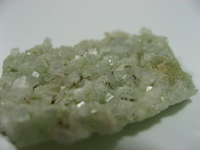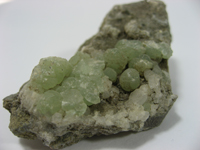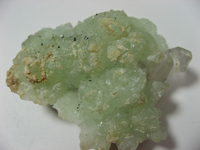![]()
Prehnite is a phyllosilicate mineral containing calcium and aluminum. Limited amounts of iron will sometimes substitute in place of aluminum in the mineral structure. In April 2000, a rare orange Prehnite was discovered at the famous Kalahari Manganese Fields in South Africa. It is mostly translucent, and rarely transparent. Prehnite is the first mineral to be named after someone, and was first described in 1789 for an occurrence in Haslach, Harzburg and Oberstein, Germany, and named for Colonel Hendrik Von Prehn (1733-1785), commander of the military forces of the Dutch colony at the Cape of Good Hope from 1768 to 1780. Extensive deposits of gem quality Prehnite occur in the basalt tableland surrounding Wave Hill Station in the central Northern Territory, of Australia.
![]()
Within the metaphysical realm of minerals, prehnite crystals will help to teach one to let go of old memories that are painful. If there has been avoidance of the truth due to pain, these crystals will assist the believer in facing, understanding, and ridding themselves of that pain. It will help one to recognize the true potent ional that lies within, the believer's divine self. It will guide in fulfilling this potential, even if it is through a mundane life; it eases acceptance of circumstance without allowing the surrender of dreams.
Please note that MIROFOSS does not suggest in any way that minerals should be used in place of proper medical and psychological care. This information is provided here as a reference only.
![]() Prehnite is generally used in ornamental work as a semi-precious gem.
Prehnite is generally used in ornamental work as a semi-precious gem.
![]()
Prehnite appears in hydrothermally altered rocks as well as a secondary mineral in mafic volcanic rocks and low grade metamorphic minerals.
![]()
Prehnite crystallizes in the orthorhombic crystal system, and most often forms as stalactitic or botryoidal aggregates, with only just the crests of small crystals showing any faces, which are almost always curved or composite. Very rarely will it form distinct, well individualized crystals showing a square-like cross-section, like those found at the Jeffrey Mine in Asbestos, Quebec, Canada. Though not a zeolite mineral, prehnite is found associated with minerals such as datolite, calcite, apophyllite, stilbite, laumontite, and heulandites.
Other than in the basic mineral form, prehnite can be found in one distinct variety:
![]()
| Cleavage | Distinct | |
| Colour(s) | Colourless, Gray, Yellow, Yellowish green, White | |
| Specific Gravity | 2.87 | |
| Diaphaneity | Sub-transparent to Translucent | |
| Fracture | Brittle - Generally displayed by glasses and most non-metallic minerals | |
| Mohs Hardness | 6.0 to 6.5 | |
| Luminescence | Fluorescent, Short UV - blue,white, peach, Long UV - Yellow | |
| Lustre | Vitreous to Pearly | |
| Streak | Colourless | |
| Habit(s) | Globular to Reniform to Stalactic | |
| Radioactivity | Non-radioactive | |
| Magnetism | Non-magnetic | |
| Electrical | Non-Electric |
![]()
No known health risks have been associated with prehnite. However ingestion of prehnite, as with other naturally occurring minerals, is not recommended.
![]()
The following image shows the Elemental breakdown of the mineral prehnite along with the mineral crystal structure.
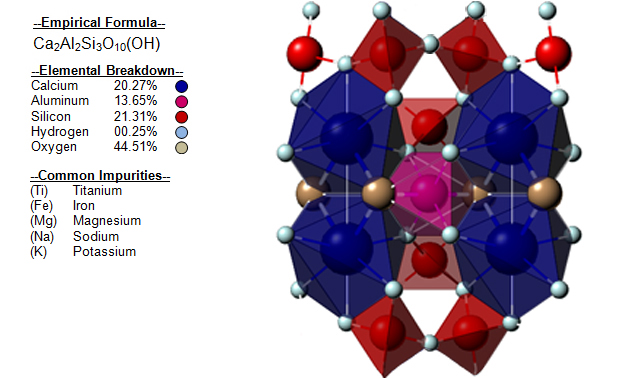
![]()
| Crystal System | Orthorhombic |  |
| Class | Pyramidal | |
| Axial Ratios | a : b : c = 0.8427 : 1 : 3.3784 | |
| Twinning | Fine lamellar | |
| Optical Data Type | Biaxial (+) | |
| Pleochroism (x) | Colourless | |
| Pleochroism (y) | Colourless | |
| RL Values | nα = 1.611 - 1.632 nβ = 1.615 - 1.642 nγ = 1.632 - 1.665 |  |
| 2V | Measured: 64° to 70°, Calculated: 58° to 68° | |
| Max Birefringence | δ = 0.021 - 0.033 (See colour chart at right) | |
| Surface Relief | Moderate | |
| Dispersion | Weak r > v | |
![]()
Prehnite can be referenced in certain current and historical texts under the following ten names:
The mineral prehnite can be translated into the following select languages:
| Arabic | Bulgarian | Chinese (Sim) | 葡萄石 | ||
| Croatian | prehnit | Czech | Danish | prehnit | |
| Dutch | Prehniet | Esperanto | Estonian | ||
| Finnish | French | Chrysolite du Cap | German | Prehnit | |
| Greek | Hebrew | Hungarian | Prehnit | ||
| Italian | Prehnite | Japanese | ぶどう石 | Korean | 프레 나이트 |
| Latin | Lithuanian | Norwegian | |||
| Persian | Polish | Prehnit | Portuguese | ||
| Romanian | Russian | Пренит | Slovak | ||
| Spanish | Prehnita | Swedish | Tagalog | ||
| Turkish | prehnit | Ukrainian | Дебати | Vietnamese |
![]()
Prehnite can be found in many places around the world. The map below shows major documented concentrations of prehnite:
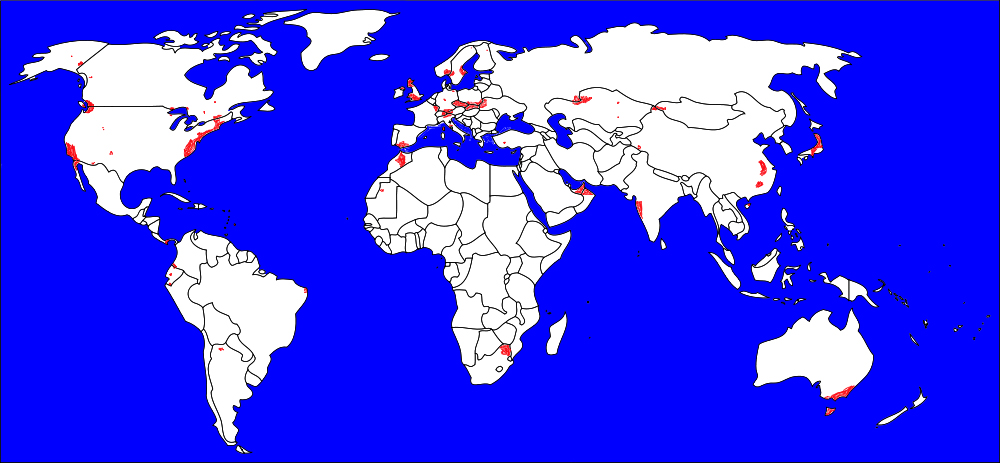
![]()
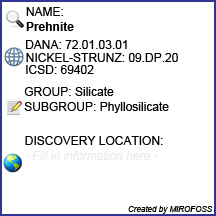 |
The MIROFOSS database offers free printable geological identification tags for personal and non-profit use. These tags can be used to properly identify mineral samples in your collection. -Click here- to download a full size jpeg image for a prehnite identification tag; which can be printed on paper or used with a plastic laser printer. |
 |
What's this? What can I do with it? |
![]()
| Chemical Composition | Hurlbut, Cornelius S.; Klein, Cornelis, 1985, Manual of Mineralogy, 20th ed., ISBN 0-471-80580-7 |
| Crystallography | F. Aumento (1968): The space group of prehnite. Can. Mineral. 9, 485-492. |
| History | European Journal of Mineralogy (1990): 2: 731-734. |
| History | Canadian Mineralogist (1987): 25: 707. |
| Geographical Data | Mindat.org. Retrieved on 2012-01-17 |
| Physical Identification | Webmineral.com. Retrieved on 2012-01-17. |
| January 17, 2012 | The last time this page was updated |
| ©2017 MIROFOSS™ Foundation | |
 |
|

